Posts Tagged ‘photography’
 2010 Field Day Beach Boys Amateur Radio Club Photographs
2010 Field Day Beach Boys Amateur Radio Club Photographs
 Emerito, N6ETO’s son Vinnie taking a tour of the ionosphere despite closed out conditions.
Emerito, N6ETO’s son Vinnie taking a tour of the ionosphere despite closed out conditions.
 Phil, KK6PE working on the laptop prior to official start while Brian and Frank troubleshoot our rotor control box.
Phil, KK6PE working on the laptop prior to official start while Brian and Frank troubleshoot our rotor control box.
 Phil, KK6PE is downloading N1MM Logger for use over the weekend. The club operated from the dialogue box while inputting mode, frequency, and callsign.
Phil, KK6PE is downloading N1MM Logger for use over the weekend. The club operated from the dialogue box while inputting mode, frequency, and callsign.
 Fred, KI6QDH and John, KG6RFW logging Saturday afternoon 20m contacts.
Fred, KI6QDH and John, KG6RFW logging Saturday afternoon 20m contacts.
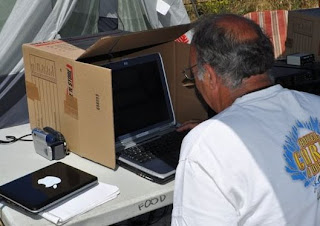 Fred, KI6QDH in the pilot’s chair and a box provided screen shading otherwise it was impossible to see one’s input.
Fred, KI6QDH in the pilot’s chair and a box provided screen shading otherwise it was impossible to see one’s input.
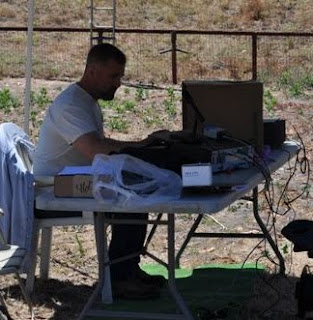 Operating our low band station. I’ve never forgotten field day in Western Pennsylvania as a novice. The low bands were always hot and fun!
Operating our low band station. I’ve never forgotten field day in Western Pennsylvania as a novice. The low bands were always hot and fun!
 Phil, KK6PE, Ricky, and John, KG6RFW manning our high band station through Saturday evening. Ricky totally dug high frequency operations.
Phil, KK6PE, Ricky, and John, KG6RFW manning our high band station through Saturday evening. Ricky totally dug high frequency operations.
 Saturday night pumps on the low bands and I’m having a blast working both short and long skip. The evening cooled off significantly enough to warrant a North Face sleeping bag and skull cap.
Saturday night pumps on the low bands and I’m having a blast working both short and long skip. The evening cooled off significantly enough to warrant a North Face sleeping bag and skull cap.
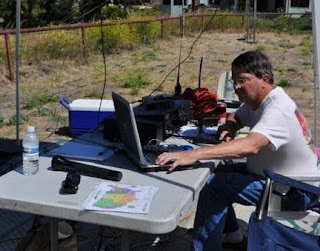 Ernie, AE6ZE who hosted our first ever field day event in the pilot’s chair on Sunday morning.
Ernie, AE6ZE who hosted our first ever field day event in the pilot’s chair on Sunday morning.
 Riding a few hours sleep and back in the chair on 40m early Sunday morning.
Riding a few hours sleep and back in the chair on 40m early Sunday morning.
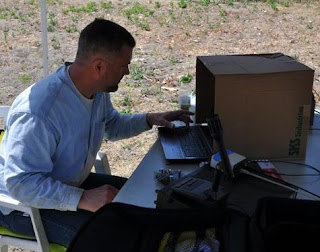 Activity shifted on Sunday as many operators went into the log as 1 Deltas and I imagine it will be an on-going, persistent trend in the forthcoming years.
Activity shifted on Sunday as many operators went into the log as 1 Deltas and I imagine it will be an on-going, persistent trend in the forthcoming years.
 KI6QDH and KI6UYB logging contacts either on 15 or 10m because 20m was not as productive as the team had hoped for through the weekend.
KI6QDH and KI6UYB logging contacts either on 15 or 10m because 20m was not as productive as the team had hoped for through the weekend.
 Kord, KI6UYB hitting his groove on the high bands mid-Sunday morning.
Kord, KI6UYB hitting his groove on the high bands mid-Sunday morning.
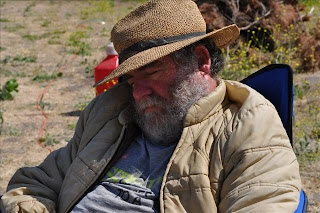 John, KG6RFW summed up our weekend beneath the warmth of Cycle 24 during the final hours of field day.
John, KG6RFW summed up our weekend beneath the warmth of Cycle 24 during the final hours of field day.
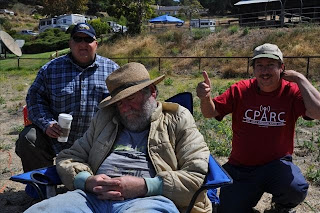 73 from the Beach Boys Amateur Radio Club and stay tuned for our next adventure!
73 from the Beach Boys Amateur Radio Club and stay tuned for our next adventure!
 2010 Field Day | Beach Boys Amateur Radio Club
2010 Field Day | Beach Boys Amateur Radio Club
 Was it a week ago when ham radio operators across the nation gathered together for a weekend of emergency wireless communications and socializing?
Was it a week ago when ham radio operators across the nation gathered together for a weekend of emergency wireless communications and socializing?
Gratitude.
I want to thank Ernie, AE6ZV for his magnificent effort as the Beach Boys Amateur Radio Club successfully executed its first ever field day. He magnified the definition of ham radio spirit while Honda generators hummed, Morse code sang into the starry night, and operators shouted into microphones.
Many thanks to Emerito, N6ETO, Fred, KI6QDH, John, KG6RFW, and Kord, KI6UYB for their inspiration, hard work, and dedication to the Beach Boys Amateur Radio Club mission — ham radio is a lot of fun!
I believe our club is reinvigorating ham radio in our local area as participants chatted up the excitement of logging their first ever HF contacts, the flush of our accomplishment, and their passion for a wonderful hobby. Our local 2m repeater will never be the same after last weekend.
Reward Is In The Effort.
We are a band of like minded with varying degrees of expertise. Our antenna systems for the weekend included an elevated Butternut HF9V with 5 quarter wave radials on the low bands (40 & 80m), a 3 element tribander at 35 feet (10, 15, and 20m), a G5RV (80m LSB), and a 40m dipole.
Propagation really depressed conditions on the high bands with a Sunday morning sporadic-e exception. Literally, 20m was gridlocked and 100 watts was not sufficient enough to conquer both conditions and signal jam when 15 and 10m are virtually shut down however; Beach Boys Amateur Radio Club logged over 200 contacts on the high bands.
A job well done for Kord, KI6UYB who logged his first ever HF contact!
Low Bands Play On.
The low bands performed beyond expectation and we were more than pleased with the performance of the elevated vertical with counterpoise. The concentration of 6 land stations on 40m had an enormous positive impact on our log statistics. Their signals ranged from barely above receiver noise floor to an astounding 20dB on the s-meter.
Forty meters made up the difference for our low power operation especially when 20m was gridlocked.
Fred, KI6QDH fired up our G5RV on 80m LSB beneath a sky ablaze with full moon light and thin, wispy tendrils of fog. His effort spiked our overall total while I logged Morse code contacts on the same band. I enjoyed listening to him as contact after contact went into the log. On the other hand, we are in need of an 80m operator who is a night owl because my brain stopped processing Morse code around 1 o’clock in the morning.
The Beach Boys Amateur Radio Club logged over 500 contacts on the low bands.
Locally Reinvigorating Ham Radio.
Our preparations paid dividends especially in terms of having a lot of ham radio fun. We had lots of visitors throughout Saturday afternoon and, hopefully, our band of passionate operators inspired individuals to look again at ham radio in addition high frequency (HF) operating.
We were wiped out when the buzzer concluded our first ever field day operation. Our team effort scored over 700 contacts in the log and we are targeting over 1,000 for next year.
Next Project?
The Beach Boys Amateur Radio Club is looking at its next project, perhaps, UHF/VHF operations near the beach with our beams pointed north/south toward San Francisco and Los Angeles. There are digital modes yet to be conquered and lots of space on HF for ham radio fun. Six meters is all the rage in the area trending Hawaiian print shirt popular along the central coast of California.
Stay tuned for the next adventure and 73 from the shack relaxation zone.
P.S. Working on my radial system this afternoon, antenna lab gets a 6m beam, and I renewed my ARRL membership.
 Beach Boys Amateur Radio Club 2010 Field Day Prep
Beach Boys Amateur Radio Club 2010 Field Day Prep
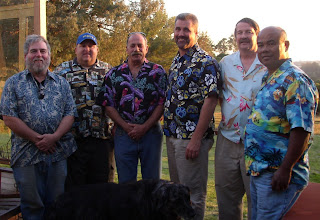 Photograph 1 Beach Boys Amateur Radio Club located near Pismo Beach, California. Our only requirement for membership is a willingness to enjoy ham radio and wear a Hawaiian print shirt.
Photograph 1 Beach Boys Amateur Radio Club located near Pismo Beach, California. Our only requirement for membership is a willingness to enjoy ham radio and wear a Hawaiian print shirt.
Photograph 2 is our field day site and note the arena’s metal fencing.
Photograph 3 is Emerito, N6ETO at the controls of an ICOM ProIII — one of two for this year.
Photograph 4 is Fred, KI6QDH who is our local ham radio motivator and 6 meter grid square chaser.
Photograph 5 taken of John, KG6RWF and I while operationally testing our field day equipment to include a Kenwood TS850S.
Photograph 6 taken while I logged K6D a special event station commemorating donuts in Southern California.
Photograph 7 taken after BBARC successfully deployed our field day tower. It is all about safety when working in and around a tower.
Photograph 8 is our tri-bander waiting for signals. We heard E4X working a 5 KHz wide swarm on 20m Morse code this morning.
Photograph 9 taken while we prepared the tower for deployment.
Photograph 10 taken of Emerito, N6ETO making an adjustment to the tri-bander driven element prior to hoisting operations.
Photograph 11 is the tower after we successfully stowed our tri-bander antenna. Our goal was slow and steady as the tower made its descent. We are planning additional guys at the mid-section as well.
Photograph 12 is the Butternut HF9V at the opposite end of the arena. We will install a counterpoise system and ground to arena fencing prior to official operations.
73 from the shack relaxation zone.
 My 10,000 Hour RadioSport Challenge | 9,804 – 1 = 9,803 Hours To Go
My 10,000 Hour RadioSport Challenge | 9,804 – 1 = 9,803 Hours To Go
The lull between solar cycle sets allowed me an opportunity to configure Ham Radio Deluxe with bandscope capability. I’m impressed with its user interface and continuous scanning. The scope settings range between 6 dB through plus 60 dB in addition I’m monitoring 75 KHz of bandwidth.
QSO Party.
Recently, I operated in the 7th Call Area QSO Party, for an hour prior to a social commitment. The recent downward sunspot trend suppressed most signals, normally, signals from 7-land range between s5 through plus 10dB on the meter. This season seems exceptionally different unlike previous years.
The Beach Boys Amateur Radio Club is wondering where all the sunspots have gone?
Software Control.
I have reached a milestone inside the shack that is additional software controlling of the Yaesu FT100 because of Ham Radio Deluxe. However I have not completed the project that is interfacing my radio because of port issues. My goal is to resolve the conflict at the end of the month although not in time for CQ WPX CW.
Currently, both N1MM Contest Logger and Ham Radio Deluxe compete on port four, which is assigned to the CAT62 cable off of the FT100.
The DM780 program runs in CW mode and I’m fascinated by the spectral intensity of signals. I feel like ham radio moved to another level because, not only am I hearing the signal, it is also visualized on the liquid crystal display. Likewise, one can watch the Morse code interpreter and I’m curious how it will function at the end of the month for example; can I cut and paste a callsign from the interpreter into N1MM’s dialogue box when searching and pouncing?
CQ WPX CW.
I’m looking forward to the late Spring mega RadioSport event given WPX growth over the past few years. Likewise, I will have an opportunity at using the bandscope and waterfall although WPX is a rate competition. Perhaps, the big question is, will a set of sunspots flow across the solar disc later this month?
73 from the shack relaxation zone.
 ShackTech
ShackTech
Photograph One is a retired Dell Dimension 2350 after my catastrophic hard disk failure. I could not depart with the machine keeping in mind the frugality of my Grandparent’s generation. I wondered why Grandpa collected those old screws, nails, nuts, bolts, and washers in baby food jars and his sensible wisdom is hot conventional wisdom in the shack relaxation zone.
Photograph two taken of salvaged memory, fire wire card, ether net card, and video card. The only tool required was a Philips head screw driver, a flashlight for my tired eyes, and my pair of hands.
Photograph three looks at the central processing unit heat sink and hinged ducting for cooling air. The collection of dust on the components was astounding at least for this neophyte geek. An annualized desk top computer cleaning program goes into motion inside the shack.
Photograph four reveals all plug-in cards removed in addition to the power supply and fan.
Photograph five illustrates how much dust really collects on one’s fan across several years. I recommend taking a serious look at cooling fans, especially, if one cannot recall its last scrubbing.
Additionally, rather than donate the Surfboard SB4100 Cable Modem as directed by Charter Communications, why not re-purpose this device? I want to thank NYC Resistor for their inspiration and my Grandfather for his relevant wisdom.
73 from the shack relaxation zone.
 Is This The End Of Ham Radio As We Know It?
Is This The End Of Ham Radio As We Know It?
I applaud Pete Smith, N4ZR, Rick Walker, K4TD, Felipe Ceglia, PY1NB, and Nick Sinanis, F5VIH for their innovation — Reverse Beacon Network (RBN) Telnet Feed combines data output of all current RBN Skimmer receivers at no-charge for ham radio operators world wide.
Is this the end of ham radio as we know it?
Certainly, not.
Boomer And Millennial.
I’m a late Baby Boomer born in 1964 at the tail end of my generation. Some say, we are the silent cohort, our voices eclipsed by earlier Boomers and the later Millenials. However, what is not recognized; we witnessed and actively participated in all the infant technologies that are now beginning to mature.
I played Atari with its read only memory cartridges. I have dialed both a rotary and touch tone phone. I watched wireless television succumb to cable when Home Box Office was a big deal on the block. We used push button remotes tethered to a cable before the ubiquity of wireless remotes. Remember, when someone actually switched channels on an analog dial?
I pushed eight track cassettes into players before cassette tapes ruled one’s Sony walkman. I participated in the battle of beta and VHS for dominance in delivering home entertainment; renting a movie was a big deal. Today, format competition continues as Blu-Ray wrestles for market share against that of DVD.
Change is not a big deal for the silent cohort or those thereafter, perhaps, it is expected, sometimes begrudgingly, sometimes with fascination.
Disruption.
However, even beyond the CQ Contest Digest discussion, a chasm exists between keeping ham radio in its purist form and technological progress. I hear those who are steadfastly resolved that ham radio is nearing an apocalypse — robots will soon replace humans in RadioSport?
I’d like to know, how many still spin their dial, looking for a DXCC counter given the near efficiency of spotting networks? Can one with a reasonable commitment to occupation and family afford such a time consuming luxury? Retirees need not answer that question.
The same is said, dial tone replaced rotary, compact disc replaced VHS, and liquid crystal displays replaced cathode ray tubes. What happened to auto-patch? Essentially, at the end of the day, it is digital change and the anxiety that follows the disruption of long established comfort zones.
Conclusion.
The Reverse Beacon Network Telnet Feed is not the end of ham radio. It is technological progression perhaps at the level of software and digital signal processing. I did not immediately leap to the idea that it is the symbolic end of RadioSport, rather, RBN is the result of hard work by a group of men who care about the longevity of ham radio.
RBN is a beginning and not the end.
See Also.
Fi-Ni Report : Contester Criticizes New Technologies.
 Droid
Droid
 Mobile device disruption of current social and/or business models is a brave new future, perhaps, ultimately displacing one’s desktop computer. Frankly, in comparison, my Droid can accomplish most tasks albeit with a much smaller screen and miniaturized QWERTY keyboard.
Mobile device disruption of current social and/or business models is a brave new future, perhaps, ultimately displacing one’s desktop computer. Frankly, in comparison, my Droid can accomplish most tasks albeit with a much smaller screen and miniaturized QWERTY keyboard.
I’m impressed with my Droid thus far and can’t help drawing parallels between it and Issac Asimov’s iRobot in addition to Star Trek communicators.
Reviews.
- Engadget Motorola DROID review (link).
- Gizmodo Motorola Droid review (link).
- Ubergizmo Motorola Droid review (link).
The last thing needed in my life is a device that drains scarce time from the mortal hourglass. I want my Droid to accomplish the following tasks —
- Synchronize email.
- Content production.
- Integration with recreational activities specifically ham radio and surfing.
- Social network integration when mobile.
- Decision data such as product and/or service(s) review.
I’m observing a mobile device viewing trend using Google analytics. I recommend thinking about one’s blog layout through the lens of Droid-like devices. Likewise, the presentation of one’s introduction, body, and conclusion as viewed on these screens.
Additionally, when producing video for YouTube, compare it against a desktop monitor and a mobile device screen.
Overall, with 24-hours of experience, I’m pleased with Droid’s near intuitive Google operating system, connectivity to the Internet, its baseline package of applications, and industrial design.
73 from the shack relaxation zone.













